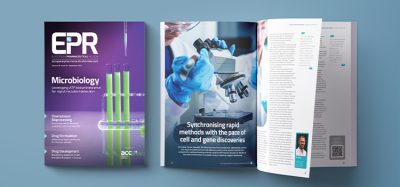Harbinger of change
The pharmaceutical industry plays a major role in the lives of individuals by providing critical therapeutic medicines. This places the industry in the public eye, as does drug pricing, safety and efficacy, the stock markets and courting with several different regulatory bodies, with differing legal requirements, around the world. The industry also employs, directly and indirectly, large numbers of people.
The pharmaceutical industry plays a major role in the lives of individuals by providing critical therapeutic medicines. This places the industry in the public eye, as does drug pricing, safety and efficacy, the stock markets and courting with several different regulatory bodies, with differing legal requirements, around the world. The industry also employs, directly and indirectly, large numbers of people.
The pharmaceutical industry plays a major role in the lives of individuals by providing critical therapeutic medicines. This places the industry in the public eye, as does drug pricing, safety and efficacy, the stock markets and courting with several different regulatory bodies, with differing legal requirements, around the world. The industry also employs, directly and indirectly, large numbers of people.
This industry however, has not changed much in terms of manufacturing and engineering practices for several decades. Technological advancements have yielded some automation, but in general and in comparison with similar industries little has changed. The reason often cited for this stale environment is regulations and their enforcement. Time and adoption, or lack thereof, of initiatives such as PAT, will ultimately judge whether this is the reason for banality.
Today, generally, we practice the routines that worked many years ago, when technology was not as advanced nor readily available. Medicines were less potent and according to some, regulations were not as stringent. Increase in potency and the ever decrease in dosage presents a challenge. So what is unique about this industry? The development, manufacturing, regulations, or the mind set with which we seem to be comfortable.
The development of a new drug can quite easily take many years. First, a new chemical entity must be identified and evaluated. Success of clinical trials and formulation is the precursor to manufacturing and marketing. The parallel regulatory process of preparation and approval, although with some involvement of the clinical trial and formulation disciplines, generally has a life span driven by market forces. Formulation and scale up, likewise, are driven by the need to fully harvest the return on investment. The goal for all parties involved is to have the product in the market generating revenue and fuelling the next product or process. At this stage the process is registered with the regulatory body(ies) and deviation from the registered process is cumbersome. The reason for this impasse is the premise that the submission was based on sound science and the evaluated practice was relevant and specific to the product. Often this is not the case as manufacturing function is presented with scale up options and manufacturing demands generated by laboratory scientists and internal regulatory professionals. Engineering and manufacturing functions are generally not consulted prior to this stage.
Manufacturing’s first hands-on encounter with the product and the defined process is the validation period. This is the time when minor changes to the process are allowed, only with documented evidence of change control strategy and methodology. The goal, always, is the manufacture of three consecutive batches, using the same process. Having achieved this, the manufacturing function is allowed to proceed on its own with routine manufacture. Problems related to manufacturing and rooted in the lack of proper and comprehensive understanding of the process may begin to surface from this point onwards. An efficiency-focused organisation would accordingly modulate the process to allow it to manage the variability of the incoming raw materials as well as the variation of the individual process units. However, this is not acceptable as the process has been ‘validated’ and variability has been taken out of the process, or in effect ‘fixed’. The purpose of this activity is, according to the Code of Federal Regulations (CFR), “to assure batch uniformity and integrity of the drug products”. The assurance of product integrity is a valid and necessary requirement. However, does ‘fixing’ the process provide this assurance and do the regulations demand what is currently practiced?
A cursory look at the regulations is helpful. The regulations [21CFR211.110 (a)] state: “To assure batch uniformity and integrity of drug products, written procedures shall be established and followed that describe the in-process controls, and tests, or examinations to be conducted on appropriate samples of in-process materials of each batch. Such control procedures shall be established to monitor the output and to validate the performance of those manufacturing processes that may be responsible for causing variability in the characteristics of in-process material and the drug product.”
Based on general consensus, change to the manufacturing process, no matter how trivial or complex, is avoided. Indeed deviations from the “validated process” will need “re-validation”, or result in regulatory actions, for example an observation notice.
This is escalated further by use of standards intended for the market place. Such standards and the associated prescriptive procedures have been used readily in the manufacturing arena. Product standards, specifically designed for the market place, have thus become the process standards. This impacts process and product specifications. The result can only be the hampering of best practices and impeding optimisation of development, manufacturing and quality assurance.
Such practices have made this industry hesitant to adjust and optimise its processes when needed, to embrace technology, or even adopt the best practices of science, engineering or manufacturing. Preparing, submitting and getting a change approved are, perhaps, seen as daunting exercises, only to be practiced as a last resort. Is such belief and behaviour, whilst increasing the cost of goods, a good prescription for either the regulated or the regulator?
The need for change was championed by the FDA when, on July 19, 2001, the PAT initiative was discussed publicly at an FDA Advisory Committee for Pharmaceutical Science. The initiative was established as a collaboration among the Center for Drug Evaluation of Research (CDER), Office of Regulatory Affairs (ORA) and the Center for Veterinary Medicine (CVM). The first cadre of the PAT reviewers, inspectors and compliance officers were selected and the training program was started in earnest. The initiative acquired momentum with the publication of the draft guidance for industry in September 2003. The initiative was further accelerated when it reached a milestone with the finalisation and publication of the guidance for industry, “PAT — A Framework for Innovative Pharmaceutical Development, Manufacturing, and Quality Assurance”. Surely, the greatest reward for those close to the initiative has been the whole-hearted adoption, by a number of firms, of the substance and the spirit of the guidance.
The PAT guidance provides a framework to support innovation and efficiency in pharmaceutical development, manufacturing and quality assurance. The guidance is founded on process understanding and process control. Control cannot be instituted without an appreciation and knowledge of what is critical and what effect it has on product quality.
Some will argue that in today’s practices, control is instituted within the process. An observation however, is that the definition of ‘control’ used in the pharmaceutical industry, generally, is different to that of the engineering communities of practice in other industries. Control requires assessment and knowledge of in-process material or product, adjustment of the physical (or chemical) attribute of the material and a process capable of eliminating or minimising the variability of the said critical attribute. Clearly this is a simple process and this practice is the norm in most other industries.
The PAT framework, because it is founded on process understanding and process control, enables the manufacturer to institute such best practices. The PAT guidance defines a process to be well understood when (1) all critical sources of variability are identified and explained; and (2) variability is managed by the process; (3) product quality attributes can be accurately and reliably predicted over the design space established for materials used, process parameters, environmental and other conditions. It is important to consider Agency thoughts, as explained in the guidance, that not all variables are critical and what steps need be taken to identify those that are critical and need to be managed. Furthermore, the process of ‘control’ is not static, but dynamic.
The result can only be higher and consistent quality, by design and not by post-production testing. The enabling process, the PAT framework, thus has two components: “(1) a set of scientific principles and tools supporting innovation and (2) a strategy for regulatory implementation that will accommodate innovation.” Its ultimate goal is control to quality through real-time control of manufacturing, thus facilitating real-time release and continuous optimisation.
PAT workshops held in the USA, UK, Japan, India and Belgium by FDA1, consistently reiterated the point that the term analytical in PAT is viewed broadly to include chemical, physical, microbiological, mathematical and risk analysis conducted in an integrated manner; and that the intent of ‘process analytical technology’ and ‘innovation’ was not just process analysers. A variety of tools and principles are needed to provide an integrated systems approach to measuring, analysing, modelling, controlling and optimising the manufacturing process – thus facilitating the goals of the PAT framework. Many of these tools and principles have been developed and employed in other industrial sectors and when used within a system, can provide effective and efficient means for acquiring information to facilitate process understanding, continuous improvement and development of risk-mitigation strategies. However, as stated in the PAT guidance, PAT tools identified are: a) Multivariate tools for design; data acquisition and analysis; b) Process analysers; c) Process control tools and; d) Continuous improvement and knowledge management tools. FDA has indicated in the guidance that successful implementation of the PAT framework requires the application of an appropriate combination of some or all of these tools to a single-unit operation, or to an entire manufacturing process and their quality assurance.
In addition to the PAT tools, PAT principles identified by the Agency and founded on process understanding are: a) Risk-based approach; b) Integrated systems approach and c) Real time release.
“Real time release” as defined by the FDA, “is the ability to evaluate and ensure the acceptable quality of in-process and/or final product based on process data. Typically, the PAT component of real time release includes a valid combination of assessed material attributes and process controls. Material attributes can be assessed using direct and/or indirect process analytical methods. The combined process measurements and other test data gathered during the manufacturing process serve as the basis for real time release of the final product and would demonstrate that each batch conforms to established regulatory quality attributes.” Therefore real time release can only be achieved with demonstration of process understanding, real time control and quality assurance during manufacturing.
Real-time control of the process allows the process to manage variability and assures product quality in real-time (or near real time) of in-process materials or drug product, and hence validates and confirms the performance of the manufacturing process. Hence, real time release will also address the regulatory requirements specified in Chapter 21 of the Code of Federal Regulations, part 211.110(a). Furthermore, adoption of the PAT principles will be closer to the said requirement (…control procedures shall be established to monitor the output and to validate the performance of those manufacturing processes that may be responsible for causing variability in the characteristics of in-process material and the drug product) than currently practiced cumbersome process validation. Within the PAT framework, most process changes do not require re-validation as each dosage unit manufactured will validate the performance of the manufacturing process.
As pharmaceutical manufacturing evolves from an art to a science and engineering based activity, application of this enhanced science and engineering knowledge in regulatory decision-making, establishment of specifications and evaluation of manufacturing processes should improve the efficiency and effectiveness of both manufacturing and regulatory decision-making. A focus on process understanding and control will also enable the use and application of relevant and functional standards, prepared by users and experts through an open and transparent consensus process. The FDA identified ASTM International as the most effective venue for developing science-based consensus standards for “process quality,” which is the focus of the PAT Initiative. This collaboration of industry, academia, FDA and ASTM International affords the pharmaceutical industry the unique opportunity to learn from other industrial sectors. PAT represents the FDA’s vision for future pharmaceutical product development and manufacture. Committee E55 addresses issues related to process control, design and performance, as well as quality acceptance/assurance for the pharmaceutical manufacturing industry (see European Pharmaceutical Review, Issue 2, 2004).
Today’s pharmaceutical manufacturing operations are inefficient and costly. The cost of low efficiency is generally not understood nor appreciated (e.g., manufacturing costs far exceed those for research and development operations). Low efficiency is predominantly due to ‘self-imposed’ constraints in the system (e.g., static manufacturing processes, focus on testing as opposed to quality by design, approach to specifications based on discrete or the so called ‘zero tolerance’ criteria, a less than optimal understanding of variability, etc.). These constraints keep the system in a corrective action mode.2 The PAT initiative is intended to emancipate the regulated and the regulator from constraints that prevent an efficient and optimised development and manufacturing milieu.
The time for change is now.
References
- The workshop in USA was co-sponsored with ISPE and AAPS. The workshop in London was co-sponsored with ISPE and the Royal Pharmaceutical Society of Great Britain (RPSGB). Those in Belgium, India and Japan were co-sponsored with ISPE.
- FDA White Paper: Innovation and Continuous Improvement in Pharmaceutical Manufacturing, Pharmaceutical CGMPs for the 21st Century (http://www.fda.gov/cder/gmp/gmp2004/manufSciWP.pdf)
About the author – Ali Afnan Ph.D
Process Analytical Technologist, FDA/CDER/OPS
Dr Ali M. Afnan, an Industrial Chemist, received his PhD in Instrumentation and Analytical Science at UMIST in 1990, when he joined the On-Line Analysis and Measurement Group at ICI Engineering. In 1993 he joined the International Technology Development Group within the Pharmaceuticals Engineering Group of AstraZeneca, where he was responsible for the development and implementation of Process Analytical Technology. He is a member of the PAT Team in the Office of Pharmaceutical Science at CDER, FDA. His responsibilities include developing agency policy and training pertaining to PAT, coordinating submissions and discussions with the pharmaceutical industry and collaborating in research ventures with industry and academia.







